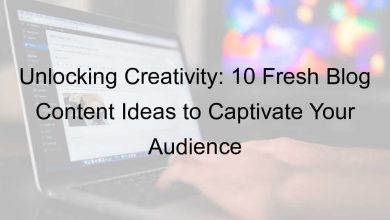Unlock Your Voice: A Beginner’s Guide to Starting Your Own Blog

Welcome to the exciting world of blogging! Whether you want to share your passion, experiences, or expertise, starting your own blog is an excellent way to express yourself and connect with others. In this guide, we’ll explore how to start a blog and provide you with invaluable blog tips for blogging for beginners. With the right tools and mindset, you can transform your ideas into engaging content that resonates with readers worldwide. So, get ready to unlock your voice and embark on this fulfilling journey of creativity and connection.

Crafting Compelling Content: Tips for New Bloggers
Starting a blog can feel like stepping into a vast and sometimes overwhelming online world. Yet, with the right approach and some determination, anyone can create content that resonates and connects with readers. If you’re asking yourself how to start a blog and make it truly stand out, you’ve come to the right place.
Finding Your Voice
The first step in blogging for beginners is to identify what makes your perspective unique. Think of it like a fingerprint: no two are exactly the same. But what if that unique voice is akin to trying to find one tree in a forest? You need to dig deep into your interests, life experiences, and the topics you are passionate about. This will ensure that your content is authentic and relatable. However, maintaining authenticity requires a delicate balance. Too much personal insight might alienate readers unfamiliar with your style, while too little could make your blog feel generic. It is both a science and an art—a labyrinth without a map.
Engaging Your Audience
Crafting engaging content is not just about presenting facts; it’s about storytelling that captivates and informs. Your readers should feel like they’re part of a conversation. But beware—this is trickier than it sounds. Missteps here might lead you down the wrong path. Consider including interactive elements such as polls or questions at the end of your posts to foster engagement. But then again, might this participation feel forced? Alas, the fine line you walk here could lead to spirited commentary or stony silence.
- Blog Tips: Research trends in your niche regularly. This keeps your content fresh and relevant.
- Consistency: Develop a posting schedule that you can maintain without burning out.
- Visual Appeal: Break up text with images and graphics to enhance readability.
- Feedback Loop: Encourage comments and interact with your audience to build a community.
- SEO Savvy: Use keywords organically while maintaining the natural flow of your writing.
The Art of Balance
In the world of blogging for beginners, balance is key. You might find yourself wondering whether to stick to a particular style or content focus. Some experts urge sticking strictly to one niche. Others advocate for exploring various topics until you find your personal sweet spot. How does a new blogger navigate this dichotomy? Is there a golden rule, or are the paths as varied as the stars in the sky?
Ultimately, the journey of learning how to start a blog and sustain it is deeply personal. While there are tested blog tips that provide valuable guidance, only you can determine the essence of your blog’s voice. Embrace the uncertainty, for therein lies the adventure. Good luck, and happy blogging!

Navigating the Blogging Platform Landscape: Choosing the Right Fit for You
In the vast, ever-evolving world of blogging, selecting the ideal platform can seem daunting. With new options continuously emerging, making the right choice carries both excitement and a touch of anxiety. Your journey starts with understanding the core essence of your blog. Will it be a haven for personal expression, or an engine for professional growth? The endeavor itself defines the path more than one might realize.
As you delve deeper, it’s critical to weigh various platforms against each other. Content management systems like WordPress offer unmatched customization and control. But therein lies the paradox: too much choice can be debilitating. On the other hand, platforms such as Medium provide simplicity and an existing audience, but lack the flexibility of a custom-built site. Herein lies the perennial balance between ease and autonomy. While WordPress enthusiasts swear by its power and versatility, others may find its complexity overwhelming.
Furthermore, consider the financial implications. Some platforms offer free services, but at the cost of limited features or ads. Others require paid subscriptions, promising professional-grade capabilities. At this point, the line between investment and expenditure blurs intriguingly, offering more than meets the eye.
Equally important is the community aspect. Certain platforms nurture communities with shared interests, providing a ready audience. This can be pivotal for those seeking engagement over sheer numbers. Thus, a connective environment often trumps solitary expansion efforts.
Decoding Features That Matter
When it comes to features, prioritize your non-negotiables. Aesthetic lovers crave design flexibility, while tech-savvy bloggers might seek plug-in extensibility. However, focusing solely on one element risks overshadowing others. It’s a dance of balancing essentials with admirable desirables.
Mobile responsiveness, SEO tools, analytical insights—these fundamental components frame a blogger’s toolkit. But remember, obsessing over tools may derail the larger creative pursuit. Ironically, blogging isn’t purely about the written word anymore; multimedia integration is rapidly becoming a must-have.
In summary, there’s no one-size-fits-all in choosing a blogging platform. Your selection reflects your needs, aspirations, and personal style. Dive deep into the nuances, weigh the pros and cons, and trust your instincts. Ultimately, the right fit empowers your voice, helping it resonate across the vastness of the digital landscape.
Building Your Audience: Effective Strategies for New Bloggers
Embarking on a blogging journey can be both exhilarating and daunting. One of the most significant challenges new bloggers face is building your audience. While creating compelling content is crucial, it’s equally important to employ strategies that effectively attract and retain readers. Here, we delve into some of the most effective strategies for growing your blog audience and ensuring that your voice is heard.
Understanding Your Niche
Before diving into the vast ocean of the internet, it’s essential to identify and understand your specific niche. Who are you writing for, and what unique value do you offer? By defining your niche, you can tailor your content to resonate with a targeted audience, making them more likely to return for more. This doesn’t mean restricting yourself entirely, but a focused approach helps establish your blog’s identity. Strategically choosing a niche requires a balance between your passions and audience demand. Finding this equilibrium will set the foundation for a loyal readership.
Crafting Compelling Content
Quality content is the cornerstone of any successful blog. Engaging, informative, and well-written posts not only attract readers but also encourage them to share your content with others. This is where the magic happens, as word-of-mouth is a powerful tool. Utilize storytelling, thought-provoking questions, and actionable advice to keep your readers glued to your posts. But remember, consistency is key. Regular updates signal to your audience that you’re committed, thus fostering trust and loyalty. However, this invariably raises the question: can you maintain high standards and consistency over the long term?
Utilizing Social Media
In the digital age, social media platforms are indispensable tools for bloggers. They offer vast opportunities to promote your blog and interact with potential readers. Each platform has its characteristics; Twitter is excellent for brief updates, while Instagram and Pinterest are more visual. Align your strategy with where your audience spends their time. Engage in conversations, respond to comments, and use hashtags strategically to boost visibility. As you grow your presence, a community forms around your blog, creating a supportive network of followers who amplify your reach.
SEO: The Subtle Art
Search Engine Optimization (SEO) is often shrouded in mystery and complexity. However, understanding the basics can significantly boost your blog’s visibility. Incorporate relevant keywords, use informative titles and meta descriptions, and ensure your site loads quickly. But beware, too much optimization can make your content feel unnatural. The trick lies in seamlessly integrating SEO practices into naturally flowing content, which might seem paradoxical but is achievable. Additionally, backlinks from reputable sites enhance credibility, so actively seek collaborations within your network.
Guest Blogging and Networking
Guest blogging on established platforms can significantly expand your reach. It introduces you to new audiences who might find your perspective intriguing enough to follow your blog. However, this shouldn’t be done arbitrarily. Choose platforms relevant to your niche and propose content that brings a fresh perspective. Networking with fellow bloggers and industry experts enables knowledge exchange and opens opportunities for collaborations. However, building such relationships requires genuine interaction and a mutual understanding that transcends mere transactional exchanges.
In conclusion, while building your audience requires time and effort, employing these strategies can create a dynamic and engaged community around your blog. Remember, success doesn’t happen overnight. It’s about staying true to your voice, consistently providing value, and being open to learning along the way. This journey is as much about personal growth as it is about growing your blog.
You Can Also Review These:
How to Start a Blog (and Make Money) in 2024: Beginner’s Guide
Frequently Asked Questions
What platform should I use to start my blog?
There are many platforms to choose from, but the most popular ones are WordPress, Blogger, and Medium. WordPress is highly customizable and offers a lot of plugins. Blogger is simple and easy to use for beginners, and Medium is great if you want to focus purely on writing.
How often should I post on my blog?
Consistency is key. It’s important to set a posting schedule that you can realistically stick to. Whether it’s once a week or once a month, make sure you can maintain that schedule consistently to keep your audience engaged.
How do I attract readers to my blog?
Promote your blog on social media, engage with your readers, and make sure to use SEO strategies to increase visibility. Write high-quality content that provides value to your audience, and participate in online communities related to your blog’s niche.



